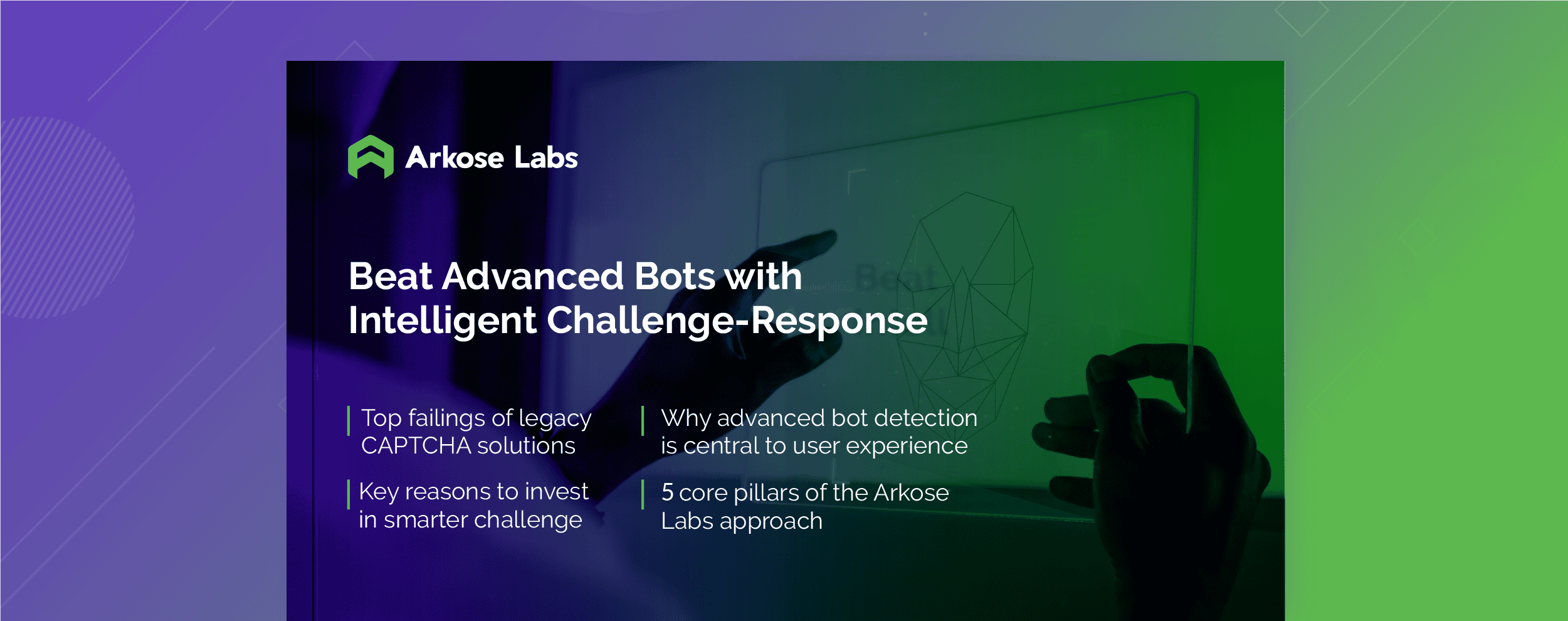These malicious software applications are designed to mimic human behavior on websites or apps. Usually deployed by cybercriminals to carry out malicious activities such as spreading misinformation, conducting DDoS attacks or inventory scraping, automated bad bots have now become one of the biggest threats to enterprises.
Identifying bot traffic within your website traffic is vital because it allows you to take action and minimize the impact of the bot attack.
In this blog post, we will tell you about the challenges of detecting bot traffic and tips that can help you spot bot traffic. You’ll also find tools that can help monitor bot vs. human traffic.
Ready to defeat advanced, automated bots? Read our ebook, Beat Advanced Bots with Intelligent Challenge-Response, and get started today!
What is Bot Traffic?
Put simply, bot traffic is non-human traffic generated by robots to web pages and apps. Bot traffic can be beneficial or harmful, depending on the purpose of the bots. Usually, bots perform repetitive tasks automatically without human involvement, like web crawlers. This automation enables a bot’s human overlord to conduct a variety of tasks.
Good bots can be used for marketing and customer service functions, data mining, and fraud prevention. However, malicious bots can also be used for credential stuffing, web content scraping or data scraping, and launching denial of service (DDoS) or account takeover (ATO) attacks. Specific “spam bots” can also be used to control a narrative on social media or leave bogus reviews on an enterprise’s site or negatively impact an enterprise’s Google search engine results.
Adding a layer of complexity is the rise of cybercrime-as-a-service (CaaS) in which bots that are tailor made for malicious activities can be purchased by would-be cybercriminals. For example, an attacker can purchase a bot for API abuse or to perform inventory scraping or steal credentials (like email addresses) from legitimate users that can be used for downstream attacks and fraud.
Due to the increased sophistication and volume of bot traffic (both good and bad) enterprises are looking for ways to manage the traffic coming to their sites. Some enterprises have implemented detection and management tools that can identify bots and take actions to curb the bot traffic. Others have come up with content filters that keep bots away from their site or apps.
Identifying Bot vs. Human Traffic
Bot traffic by design is automated and triggered by computer processes. As bots become more advanced – aided by both AI and machine learning (ML) – legitimate requests to a website can also be made by bot traffic, and bot traffic can even mimic human behavior.
When it comes to understanding the traffic hitting your enterprise’s online presence, detection is key. Bot detection involves analyzing all traffic to a website in order to detect and block malicious bots or botnets. A botnet is a network of compromised computers infected with malicious software or malware that are used to send and receive commands from a bot without human intervention. This allows cybercriminals to attack enterprises at scale.
It is important to identify bot traffic in order to protect confidential or sensitive information and stop criminal activities. A common way of identifying bad traffic is looking at its behavior patterns across various sources such as browser, operating system, device type, IP address, source country code, source domain name, referrer URL, device type, among others.
Challenges in Detecting Bot Traffic
Bot traffic can be tricky to identify as it has evolved from basic automated scripts to more sophisticated programs that can even mimic human behavior. To identify bot traffic, website engineers can use network requests and integrated web analytics tools.
Abnormal spikes in page views, unexpectedly high or low session duration, and an abnormal and unexpected increase in failed login attempts can be indicators of bot traffic. These indicators may not always be accurate, and it's important to consider other possible causes, but they are a good place to start when investigating bot traffic on a website.
Using CAPTCHAs or reCAPTCHAs as security mechanisms can help prevent malicious bots from accessing and exploiting resources on websites, but they may not always be the right tool for the job when it comes to mitigating advanced bots. A good practice is also to limit access to non-human IP addresses by using a content security framework like H2SEO or W3C’s Content Security Policy (CSP).
Website engineers should look at specific JavaScript firing and iframe tampering as indicators of bot traffic. When webmasters see these signs, it's a good idea to investigate the site’s traffic source further.
It is also important for enterprises to invest in bad bot detection and bot management tools that go beyond traditional CAPTCHAs and other basic bots-blocking measures. They can help identify bad bots and stop them before they cause damage to your website, brand reputation, or customers.
Minimizing the Impact of Bot Traffic
To minimize the impact of bot traffic, organizations should implement strategies such as whitelisting good bots and setting traps for malicious bots through the use of honeypots. Bot traffic can be minimized by using a combination of security measures such as firewalls, anti-spam, and anti-virus software. Organizations should also consider implementing stricter ad targeting rules that prohibit bot traffic.
While enterprises have previously used geofencing to block bot traffic from specific locations, the use of advanced bots and botnets, along with spoofed IP addresses, can obscure a bot’s origin. Additionally, blocking entire geographic regions can have an adverse effect on legitimate visitors and consumers looking to access a website.
What should you do if you have already been affected by a bot attack?
If you have been affected by a bot attack, you should immediately identify and block the bot or by redirect the bot to a different page. You can also use the robots.txt file to set up a honeypot in order to trap malicious bots. This will help you distinguish between good bots and bad ones. A good bot is one that follows human interaction guidelines and performs tasks as directed by the site’s content owners. A bad bot is one that doesn't follow human interaction guidelines and may harm the site's reputation or performance.
An example of a malicious bot would be one that clicks on ad banners non-stop or fills up the website’s page with spam content. These bots are difficult to detect as they simulate human activity such as clicking on-page elements. The best way to identify malicious bots is by analyzing their behavior and collecting quality data.
Tools to Detect Bot vs. Human Traffic
The best way to avoid a malicious bot attack is to detect and then mitigate malicious bot traffic. Bot detection is the process of analyzing all the traffic to a website, mobile application, or API, in order to detect and block malicious bots. Bot detection can involve distinguishing bot traffic from human behavior online, and can be complex due to the presence of four different generations of bots - web bots, mobile bots, artificially intelligent bots (or bots with artificial intelligence or AI), and human-like bots.
While bot traffic may seem harmless, it can lead to serious consequences if left unchecked. It is vital to monitor bot traffic so that websites aren't compromised by malicious software or hackers. This reality means detecting malicious bot traffic in real time is of the utmost importance. This will empower security teams to make informed decisions on how to best respond and harden any existing vulnerabilities.
Traditional bot detection and bot management tools, like CAPTCHA, don’t always work as advanced bots and botnets can typically bypass them. Additionally, traditional tools can’t always differentiate between a malicious bot and legitimate human users. This means that your customer may be presented with frustrating challenges to get past, hurting the user experience.
Arkose Labs’ Bot Management Solution Wins
Given the level of traffic competition and saturation in today’s digital landscape, the need to detect bot traffic has never been more pressing. Not only can bot traffic put your enterprise’s online presence at a security risk, but it can also hamper site performance and hinder user experience. It is crucial to implement bots-detection software that can help prevent bot attacks, protect your website from spam traffic, and improve site performance.
Arkose Labs’ bot management solution meets the threat posed by bots head on. Arkose MatchKey challenges use state-of-the-art, variable challenges that malicious entities need to solve. This makes it incredibly difficult for cybercriminals to automate their attacks in an attempt to bypass these challenges.
Better yet, Arkose Labs’ bot management software is intelligent enough to differentiate between legitimate human users and malicious bots. This means that while bad bots will receive increasingly difficult challenges to solve, most good human users won’t be challenged at all. This improves the consumer experience and keeps bad bot traffic at bay.
If you would like to learn more about how Arkose Labs can partner with your enterprise to detect and mitigate bad bot traffic, book a meeting or schedule a demo with us today.


